Have you noticed an unusually suspicious-looking cluster of eggs on the leaves and other parts of the plant?
The chances are that your houseplant is already affected by severe pest infestation.
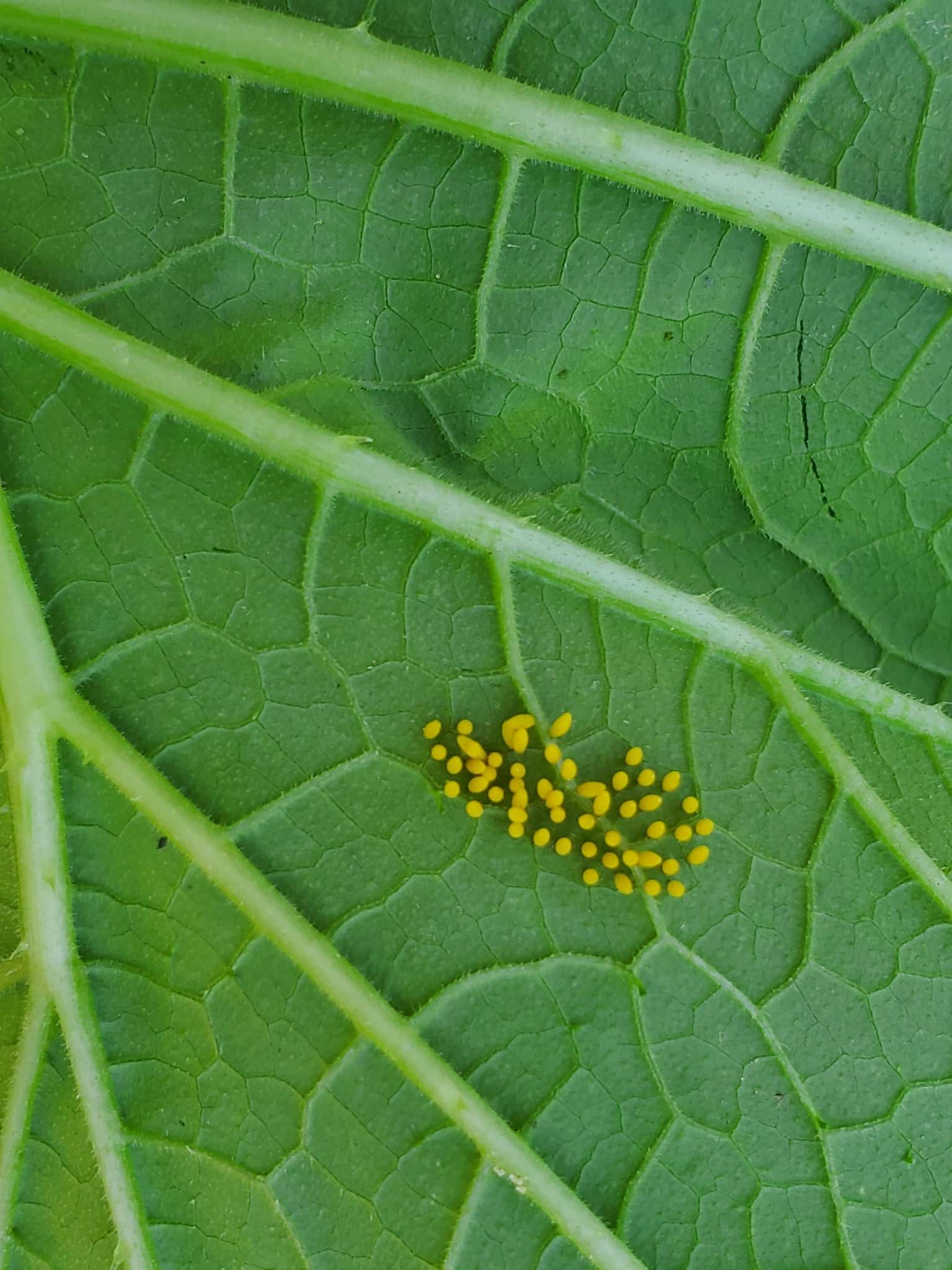
However, not all bug eggs indicate a pest infestation.
Some good bugs may also leave their trace by laying eggs on plant leaves.
Therefore, start with identifying the bug eggs and type of infestation before applying effective treatment.
Here is a complete guide to help you treat pest infestation by identifying insects and their eggs.
Table of Contents Show
Insect Eggs on Leaves –What Does it Mean?
Although pests are common occurrences on plants, most growers fail to identify the infestation on time.
Soon enough, the insects will start infesting and reproducing, which becomes apparent with their eggs!
Some common bugs that infest houseplants include:
| Pests | Damage |
|---|---|
| Aphids | They suck the sap out of plants |
| Mealybugs | They feed on plant juices of greenhouse plants |
| Cicadas | They mainly infest on young or newly transplanted shrubs |
| Colorado Potato Beetles | They infest on potatoes, eggplants, tomatoes, and peppers |
| Earworms | They destroy seedlings and leave a watery cavity in fruits |
| Squash Bugs | They suck leaves dry and feast on fruits |
| Flea Beetle | They feast on young, tender produces |
| Scales | They cause premature leaf drop and discoloration of leaves |
When you find visible bug eggs on your plant, you should know that your plant is already infested.
You would likely find the infestation at the end of the growing season when the plant becomes full.
The fresh foliage and juicy saps in the growing season attract the bugs. When they are left untreated, they increase and start reproducing.

These eggs would sit idle throughout the plant’s dormancy, only to hatch right before spring.
However, not all bugs are considered pests. Some are simply innocuous.
A few garden bugs are called Beneficial because they feed on nasty bugs and help with the pollination process.
Some of these common Beneficial and innocuous bugs include:
- Lady Bug – They eat aphids and other soft-body insects
- Lacewings – They eat aphids and other bugs up to 200 per day
- Hoverfly – They feast on minor bugs
- Dragon Fly – They feast on mosquitoes, moths, midges, and flies
These hardworking insects often lay eggs on plant leaves and soil which can be mistaken for pest infestation.
Therefore, you must identify the good from nasty bugs and their eggs before taking any crucial step.
How to Identify Beneficial Bugs Eggs?
Here is a brief guide to help you identify the eggs of beneficial bugs.
| Bug | Eggs |
|---|---|
| Lady Bug | The eggs may look slightly different based on their species. Overall, you would notice pale-yellow to white or white to bright orange/red looking eggs. |
| Lacewings | Lacewing lays up to 600 eggs in white color, hanging under the leaves by a thread-like feature. |
| Hover Fly | Their eggs are usually creamy white and oval. |
| Dragon Fly | The exophytic eggs are round in shape, laid in a jelly-like substance. |
One way to encourage beneficial insects in your garden is by scattering insectary plants.
Planting nectar and pollen sources may encourage the arrival of beneficial bugs but strictly avoid using insecticides and pesticides that may kill beneficial insects.
Alternatively, you can provide an insect stack made from canes, twigs, and cones to shelter beneficial insects.

Common Signs of Pest Infestation in Plants
Most pests do not lay eggs until the end of the growing season.
Even if they do, they tend to hide their eggs using cocoons or underneath the leaves. Therefore, you should look for other tell-tale signs of pest infestation.
A plant suffering from an infestation will give an impression of an unhappy plant that includes:
1. Changes in Leaf Color
Changes in leaf color or texture are often the primary sign of pest infestation.
You would notice spotted or speckled leaves with slight discoloration.
In some cases, the leaves start developing yellow and brown spots, caused mainly by mealybugs.
To assess if any disease is causing leaf discoloration, check for root rot or blight problems by inspecting the plant roots.
Find out how pest infestation can cause sudden change in color
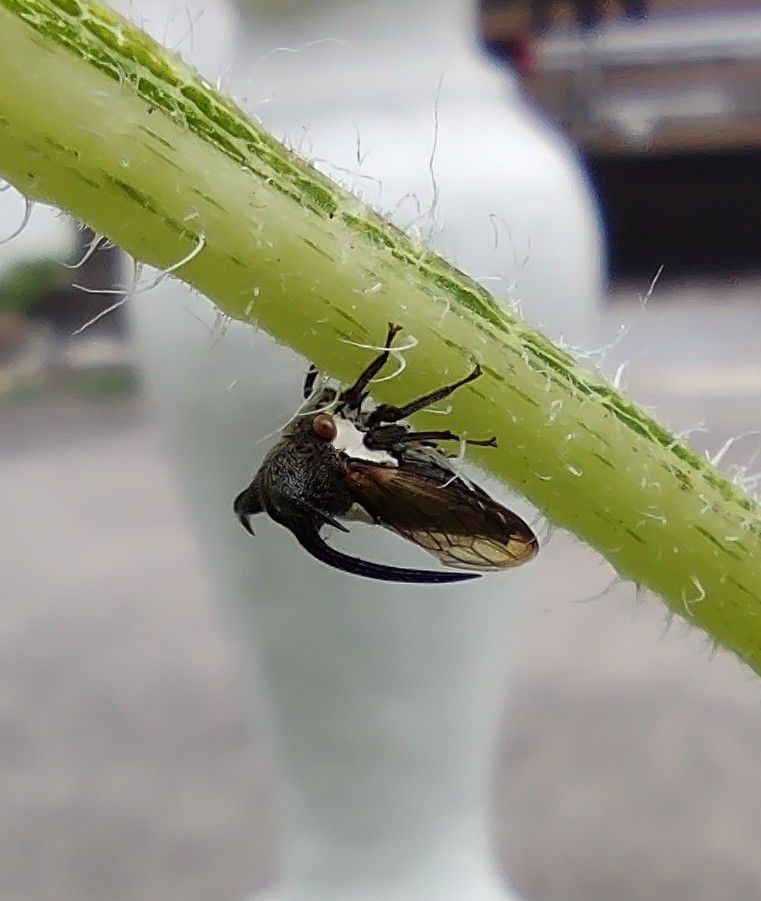
2. Distorted or Misshapen Leaves
Along with changes in leaf color, check for other associated signs like distorted leaf shapes.
An infested plant often shows distorted leaves like wilting, crumbling, or small holes around the plant.
A bug may suck the sap dry, causing untimely wilting and crumbling of leaves. Multiple holes in leaves are a clear indicator of bugs feasting on the cellulose.
Distortion is mainly caused by aphids, shoot moths, cone worms, fungal pathogens, and bacteria.
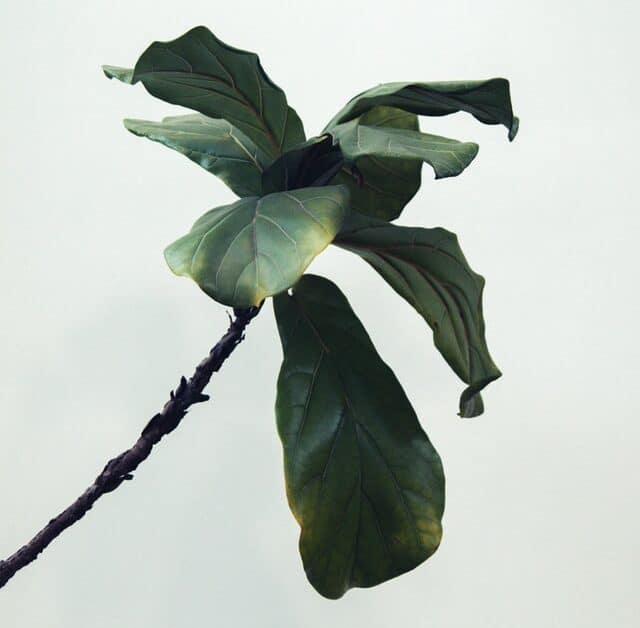
3. Droopy Leaves and Leaf Loss
The stems and leaves may start drooping upon a severe infestation of sap-sucking bugs.
The sap-sucking bugs feast on plant juices, causing a dry plant that wilts outwards.
To avoid confusing droopy leaves and stems with moisture-stress plants, check for visible signs of bugs underneath the leaves and soil surface.
Leaf Loss is more apparent in the plant severely infested by aphids.
4. Stunted or Distorted Growth
Aphid infestation is a significant culprit for stunted or distorted plants. They suck out sap that impedes the healthy growth of the plant.
The affected plant may show stunted and distorted growth, which may further increase.
5. Sticky Webbing and Sticky Brown Spots
Sticky webbing around the leaves and stems are signs of spider mites, while damp brown spots are signs of scale insects.
Spider mites are easy to spot because of their sticky webbings.
In the case of scale insects, check for sticky residue (honeydew) with brown spots on the leaves.
6. Curling Leaves
Curling leaves are one of the primary signs of pest infestation, mainly sucking insects.
The insects like aphids, thrips, and whiteflies will suck the sap out of the young plants leaving them curling.
However, do not mistake curling leaves caused by pests with inappropriate watering schedules or sunlight.

How to Identify Bugs and Their Eggs?
The bugs often lay eggs upon infestation, making it easier to identify the type of pests.
While some eggs rest separately, others may rest in a cluster. Many bugs lay eggs over the leaves, but some may place their eggs underneath as well.
When you can successfully assess these factors, you can quickly determine the type of bug and level of damage they have done.
There are types of insects that feed on plants and do the damage differently.
| Types | Insect |
|---|---|
| Sucking insects | Cotton leafhopper, Aphids, Whitelfy, and Green-belly stink |
| Chewing insects | Flea Beetle, Tobacco hornworm, Cabbage looper. and Elm leaf beetle |
| Boring insects | Termite, powder, post beetles, and longhorn |
| Mining insects | Leaf blotch miner moths, Midget moths, Liriomyza, Holly leafminers |
To make matters simple, we have compiled a list of all significant pests prevalent in houseplants.
1. Aphids
Aphids or plant lice are the most common egg-laying bugs prevalent in most houseplants, including Syngonium, hydrangea, roses, nasturtiums, etc.
These tiny insects are smaller than 1/8 inch and are often found in green, yellow, black, or white color.
Did you know Aphids produce multiple generations in a single year, causing the infestation to often reach out of hand?

They quickly reproduce, leaving honeydew-like substances and eggs underneath the leaves, flower buds, and soil.
To avoid predators, their eggs are elliptical to chisel-shaped and glued to or attached by a thread covered with a wax-like substance.
Unfortunately, the incubation period for eggs is only 7-8 days, meaning they reproduce and increase quickly.
2. Spider Mites
Spider mites are tiny (less than 1mm) predators that infest several houseplants species.
They thrive in hot, dry conditions caused by overheating and excess fertilization and are usually found underneath the leaves where they spin their protective silk webs.
A single insect can damage the plant by puncturing into plant cells to feast.

They lay over 100 tiny, spherical eggs within 2-4 weeks. The eggs coating looks transparent and is usually protected by silk webbing to keep predators away.
3. Mealybugs
Mealybugs are soft-bodied, tiny insects that are easily visible on plant underleaves and stems.
You will find a cluster of mealybugs on stems and leaves when your plant is infected.
These tiny bugs suck the sap out of the stems, leaving them dry, deformed, and wilted.
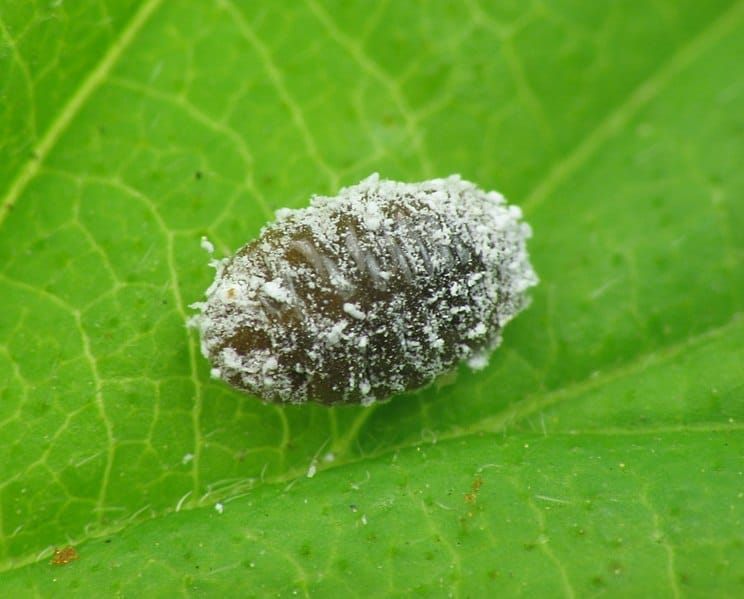
Excess mealybug infestation shows signs of yellowing foliage, leaf drop, and stunted growth.
Moreover, they are hard to control when their number increases.
An adult bug can lay 100-200 eggs over a 10-20 days period. However, these eggs can hatch within a week or two when the conditions are right.
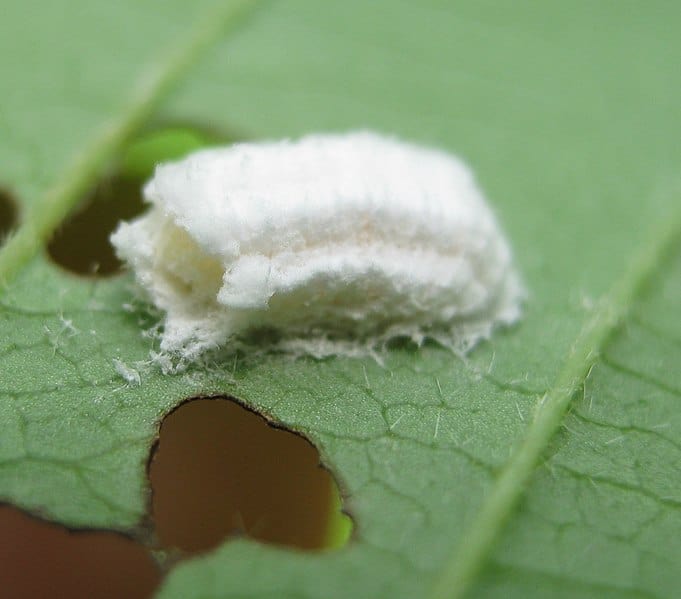
You would find white, cottony egg sacs attached to leaves, crowns, bark, and fruit.
4. Cicadas
Cicadas are tiny jumping bugs similar in nature to leafhoppers and froghoppers.
They are loud ones and make noise wherever they go, producing sound up to 80 dB.
Cicadas are primarily found in trees and plants with barks, where they use their straw-like appendage to suck sap from xylem tissue.

Although they do not damage blossoms, they may damage new and young plans.
The tiny, white eggs in the shape of rice seeds are harder to locate by the naked eyes.
Under optimum conditions, the eggs will hatch in 6-10 weeks into nymphs that fall to the ground and start burrowing underground to reach the roots.

5. Colorado Potato Beetles
Colorado Potato Beetles are tiny (10-15 mm) beetle-bugs in black, brown, and yellow colors.
You could identify adult beetles with their stripped wings and larvae by their tiny, red thorax.
They most feast on tubers, eggplants, and tomatoes and usually eat at nighttime.
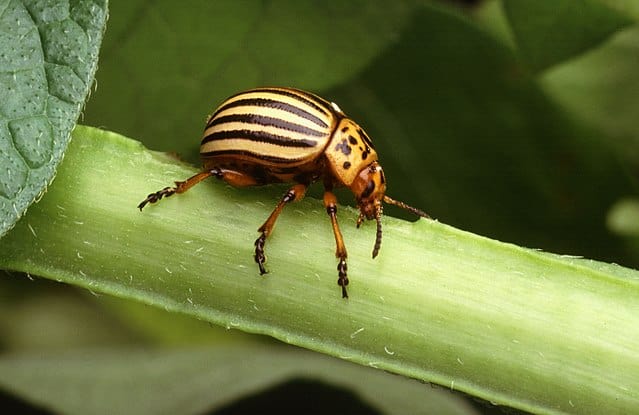
They most infest plants in spring and start laying clusters of 10-30 eggs on the undersides of leaves.
You could quickly identify their eggs by their color. The yellow-colored eggs are usually found in clusters.
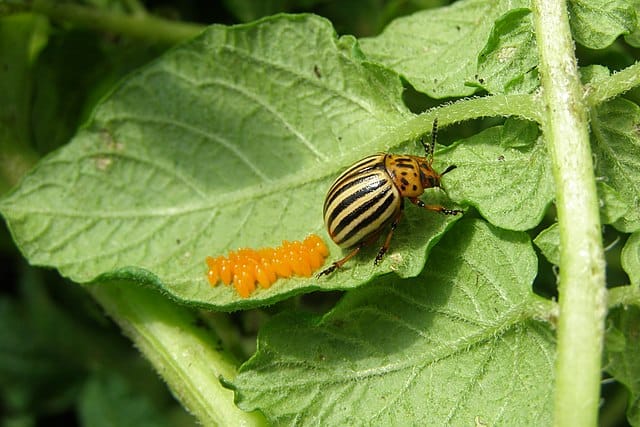
6. Japanese Beetle
Japanese beetles are the most notorious of pests because they eat up leaves from many different plants.
A species of scarab beetle, the adult beetle measure 15 mm and has a copper-colored body.
The Japanese beetles usually attach plants in clusters and eat up green leaves and fruits.
The larva or grubs are equally notorious because they also feast on leaves. They chew the grassroots, causing the turf to brown and die.
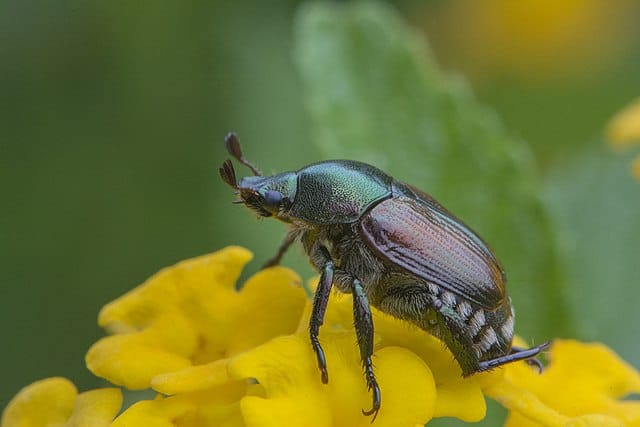
A single beetle can lay up to 60 eggs, usually in sunny, grassy areas. You would identify their eggs colored in white or cream.
You would identify the grub by their C-shape body in white to cream color with a distinct tan-colored head.
7. Flea Beetle
Flea Beetles are much similar to Japanese beetle in shape and size and primarily feast on leaves.
They chew small pits that produce shot-hole wounds. Extreme infestation can damage plant’s appearance and even slow its growth.
These jumping bugs are tiny (1/16-1/8 inches) and are often found in black, bluish, or brown colors.

They become active in early spring. A female bug can lay single or clusters of eggs in cracks, roots, soil, or leaves.
In warm conditions, the eggs will hatch in 7-14 days. The larva will primarily feed on the soft foliage and emerge as an adult within 11-13 days.
Severe infestation may even cause plant wilting or blight.
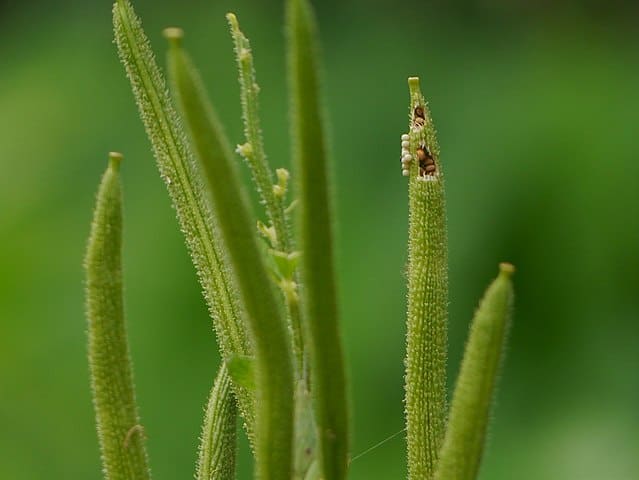
8. Scales
Scales are the nasty plant pest that sucks the sap from the plant and creates honeydew that attracts ants.
You would find two different types of scales; soft and armored scales.
Soft scales are smooth and cottony and about 1/8 inch in size. They usually feed on fluid-containing plant tissue and excrete honeydew.

Plants affected with scales may experience yellowing leaves, premature leaf drop, and leaf discolored.
On the other hand, Armored scales are tinier than soft scales that do not produce honeydew.
They often lay eggs underneath the plant leaves in thousands and cover them with a white, waxy substance.
9. Corn Earworm
Corn earworm is a flying bug that becomes active during the summer months.
The adult earworm looks like a yellowish-green moth with wings, while larva may vary in color from whitish to green.
They most infest on corn seedlings, tomatoes, flower buds, and young fruiting.
They reproduce during summer and lay about 500-3000 eggs that hatch immediately in 3-4 days.

You could quickly identify the eggs by their pale green color that slowly turns yellow and gray with time.
The shape varies from dome-shaped to a flattened sphere.
Upon hatching, the larva enters a suitable feeding site to feed and grow into pupae and adult earworms in about 13 days.
Look for multiple penetration sites on single corn. In this case, you would find more than one larva.
Here is a detailed video about identifying insects prevalent in your garden.
Treatments for Pests and Their Eggs
Finding an effective pest treatment may depend on the severity of infestation and pest types.
A non-chemical and organic work quite well in some cases, while others may require chemical agents like insecticides.
Here are different control methods to treat pests and bugs’ eggs.
1. Chemical Control
Chemical control includes using chemical agents such as insecticides, pesticides, and miticides to treat pest infestation.
However, chemical agents may also affect the plant’s health, beneficial insects, and humans because of their chemical properties.
Therefore, using the chemical agent in moderation is the key to successful pest control.
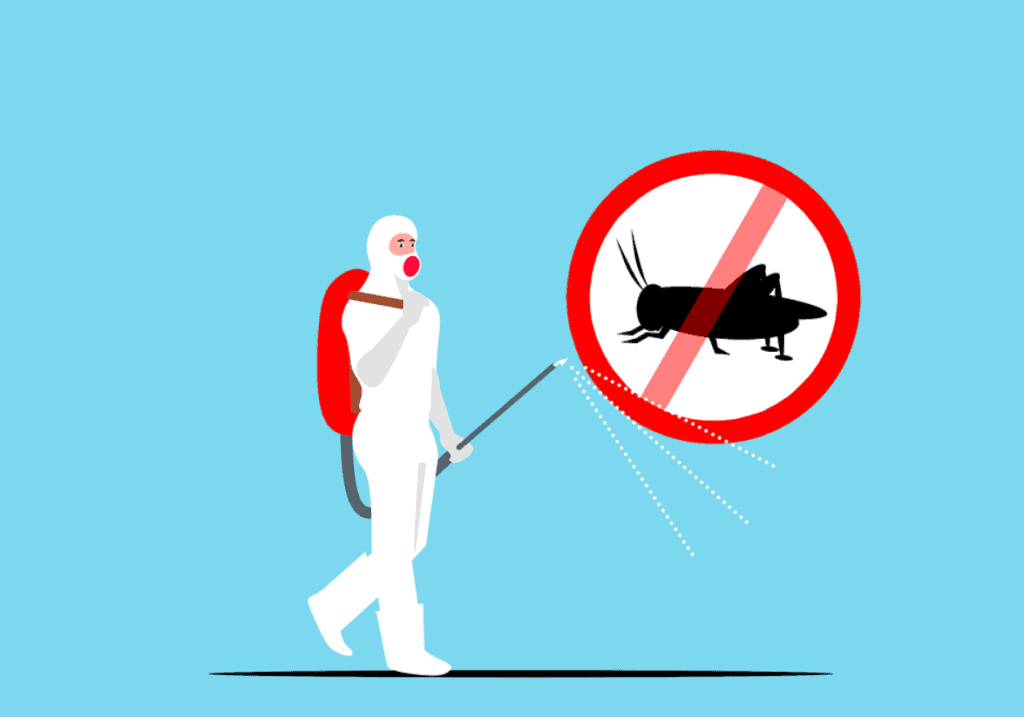
Common chemical control for managing pests and their eggs includes:
- First, prepare a soapy water solution by mixing liquid soap (Castile) and warm water, and rinse the plant leaves to kill Aphids, Spider Mite, Mealybugs, and Flea Beetle.
- Apply mineral oil on the infected part to kill off eggs and larvae of Corn Earworm.
- Soak cotton balls in 70% rubbing alcohol and wipe the infested plant to kill pests like Spider mites, Mealybugs, and Flea Beetle.
- Use horticultural oil to kill eggs, larvae, and adult bugs, including Scales, Spider Mites, and Mealybugs.
- Apply fungicides to kill Cicadas and prevent infestation for up to 90 days.
- Dust your plant with a plain talcum powder to remove and repel adult flea beetles.
- Use specialized beetle-insecticide like Azadirachtin and Spinosad to control the infestation of Colorado Potato Beetle.
Here is how you can apply insecticides to the plant.
- Mix the insecticide with water as per the direction given in the container before spraying it onto the plant.
- Spray it thoroughly over each plant to increase its effectiveness.
- Consider applying insecticide in the morning when insects are most active.
Note: Beware of using harsh insecticides that could kill beneficial insects and affect human and pet health.
2. Non-chemical Control
As the term suggests, non-chemical control uses agents that do not include a single trace of chemicals.
It is an integrated pest management strategy that reduces pest populations by employing natural enemies of the pests, physical control, and everyday household items.
The non-chemical control includes the following.
a. Biological Control
Biological control or biocontrol involves controlling pests using biological agents, such as releasing beneficial insects into the garden.
Beneficial insects are the natural predators that eat up nasty pests and their larvae and eggs.

You can either conserve the existing natural enemies in the garden or introduce new ones by establishing their population.
Here are some of the biological controls for managing pests and their eggs.
- Encourage natural predators like parasitic wasps into the garden to kill Japanese beetles.
- Release biological predators like the bacterium Bacillus thuringiensis to keep the earworm population at bay.
- Stinky bugs, Green Lacewings, and Lady beetles are pests for eating up Potato Beetles, Mealybugs, and Aphids.
- Encourage small birds like wren or chickadees to feast on Aphids, crawlers, and flying bugs.
- Wasps, mantises, spiders and are very effective in reducing the population of Cicadas.
b. Organic Control
Organic control includes pest management using a control that does not use manufactured chemicals.
It typically involves using naturally derived substances like salt, vinegar, lime sulfur, and neem.
The benefit of using organic control is that it does not leave any toxic residue on the plant and does minor damage to natural predators.
Here are some ways to control pests by organic methods.
- Dust diatomaceous earth around the base of the plants to kill crawling bugs like Aphids.
- Prepare a mixture of water and mineral oil, vegetable oil, or horticultural oil and spray it onto the plants to kill the bugs.
- Buy a neem oil spray or prepare one by mixing neem oil and water to spray on the plants. It is effective in treating scales, aphids, potato beetles, mealybugs, and spider mites.
- Try a homemade method of spraying onion, garlic water, or neem oil over the plant to kill the eggs.
- Although primarily a preventive measure, growing pest-repelling plants in your garden can somewhat control the pest population.
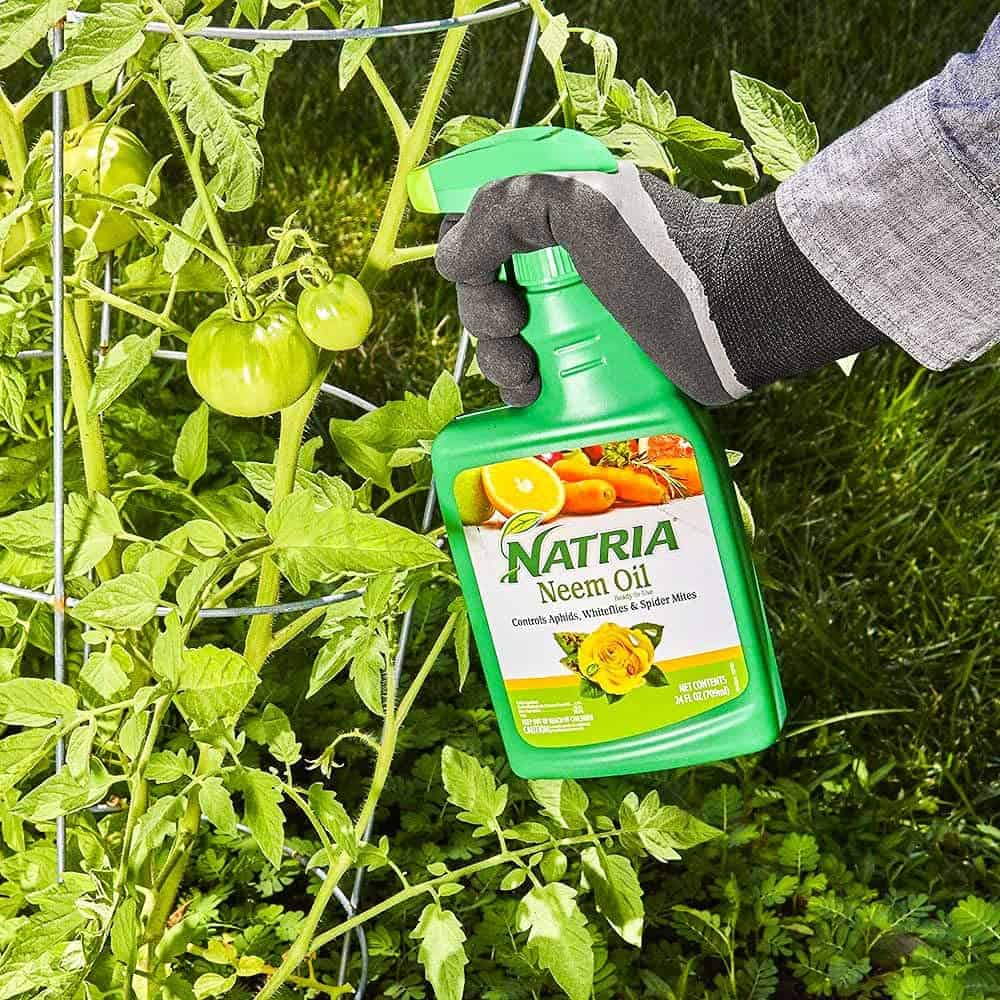
c. Physical Control
The physical control of pests is a method of treating problems either mechanically or by affecting their behavior.
Physical control primarily includes active human participation such as laying traps, catching prey, and disposing of them.
Most pest problems, before they turn into infestations can easily be treated by physical control.
Here are some ways to physically control pests.
- Dispose of the infected parts of the plant or heavily infested plants to prevent further infestations by pruning.
- Prune the infected roots and shoots before repotting them in a new container may also help kill deadly pest eggs and larvae.
- Use white sticky traps to capture jumping and crawling bugs like Flea beetle and cicadas.
- Pick mature-looking cicadas, spider mites, and beetles by hand and dispose of them immediately.
- Spray water using a garden hose to remove insects and eggs from the plant.
- Place insect traps near the entry point to trap spider mites before reaching the plant.
The use of either chemical or non-chemical control will depend on the pest types and severity of the infestation.
How to Prevent Pests from Laying Eggs on Your Houseplant?
You can prevent the onset of pest infestation altogether by creating a conducive growing environment.
However, once the pest invades your houseplant, no preventive measure will stop the pests from reproducing and laying eggs.
Therefore, we have compiled a list of a few proven ways to prevent houseplant pests altogether.
- Check for signs of pests under leaves and soil before bringing any plant inside your home, especially during summer and fall.
- Avoid bringing fresh cuttings, lawn grass, and dead foliage that are a significant carrier of pests inside your home.
- Keep your plant in an appropriate location and lighting to prevent a bad growing condition.
- Rotate the site of nightshade plants each year to avoid bugs that already live there.
- Water your plant appropriately to avoid dampening the soil that invites moisture-loving pests.
- Always use sterilized pots, pruning tools, and fresh soil when repotting the plant.
- Seal cracks and crevices on walls and doors to keep pests from entering your house.
- Grow pest-repelling plants like basil, mint, marigolds, catnip, garlic, rue, basil, and chives, along with other houseplants.
- Apply vegetable oil on the corn tips and plant stems to prevent earworms from crawling into the corn holes.
- Cut and dispose of weeds and overgrown grass in the fall to prevent insects from entering inside for overwintering.
- Keep plant beds free of debris, dried foliage, and droppings that provide a hiding place.
- Spraying branches with essential oil, peppermint, vinegar, or eucalyptus can help repel Cicadas.
- Avoid keeping your houseplant too close to each other or nearby garden plants.
FAQs About Insect Eggs on Leaves
Here are some of the frequently asked questions and their answers about insect eggs on leaves.
1. Are Dotted Leaf Bumps the Insect Eggs?
If you notice a leaf dotted with red or brownish bumps, which are hard to touch, it could be leaf galls.
Leaf galls may look similar to insect eggs, but they are simply plants’ responses to irritation.
The hard bumps, sometimes hollow protrusions, may appear due to insects feeding on the plant, fungi, and mites.
Clearing the bug infestation from the plant will treat leaf galls.
2. Does Winter Kill off Bugs and Their Eggs?
Not really! Most plant-related bugs hibernate in winter.
They build a cocoon around themselves or seek shelter in small cracks underneath the soil and inside bushier foliage throughout the winter.
Insect eggs, especially aphids, can easily survive the winter as a protective layer protects them.
The eggs will hatch once the temperature rises in early spring or summer.
3. Should you Allow Beneficial Bugs to Lay and Hatch Eggs?
Beneficial insects like the ladybug, hoverfly, lacewing help gardeners by feasting on harmful pests.
You should identify the beneficial bugs and their eggs, so you do not end up harming them when trying to kill harmful pests’ eggs.
Here is a report about preserving beneficial insects in your garden.

4. Are Indoor Houseplants Equally Susceptible to Pests?
Indoor houseplants may see fewer insect pests than outdoor plants, but they are not pest-free.
Most pests found on indoor plants are often tiny insects like aphids, scales, and mealybugs.
They enter your house from the nearby garden, fresh plant cuttings brought from outside, and nearby outdoor plants.
Sometimes, extreme growing conditions such as high humidity or lack of air circulation may attract pests like aphids, spider mites, and fungus gnats.
5. How do you Protect Indoor Plants from Insect Eggs?
Insect eggs may only result from pest infestation.
Therefore, you can control pests by keeping your indoor plants healthy, cleaning the soil and pot during repotting, and maintaining indoor growing conditions.
Growing pest-repellant plants along with ornamental plants may help keep pests away.
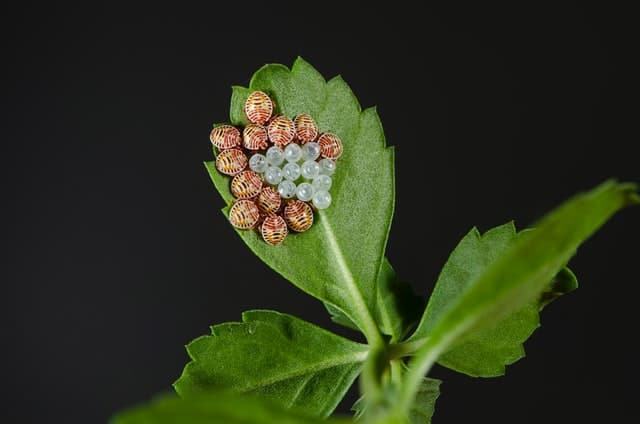
If your Orchid is drooping, learn about the causes and fixes.
Wrapping Up
Start by knowing what a healthy plant looks like, so you can catch the signs of pest infestation early on.
Most pest infestation and insect eggs can be effectively treated using insecticides/ pesticides, Neem Oil, and horticultural oil.
However, many pesticides can be harmful to beneficial insects and may kill them.
Therefore, use the guide above to identify the pests and their respective treatments before randomly applying a market-brought pesticide.
